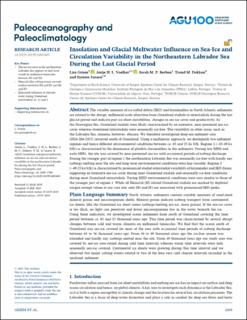| dc.contributor.author | Griem, Lisa | |
| dc.contributor.author | Voelker, Antje H.L. | |
| dc.contributor.author | Berben, Sarah Miche Patricia | |
| dc.contributor.author | Dokken, Trond Martin | |
| dc.contributor.author | Jansen, Eystein | |
| dc.date.accessioned | 2020-04-30T11:08:04Z | |
| dc.date.available | 2020-04-30T11:08:04Z | |
| dc.date.created | 2020-03-12T13:17:38Z | |
| dc.date.issued | 2019 | |
| dc.identifier.citation | Paleoceanography and Paleoclimatology. 2019, 34 (11), 1689-1709. | |
| dc.identifier.issn | 2572-4517 | |
| dc.identifier.uri | https://hdl.handle.net/11250/2653047 | |
| dc.description.abstract | The variable amounts of ice rafted debris (IRD) and foraminifers in North Atlantic sediments are related to the abrupt, millennial‐scale alteration from Greenland stadials to interstadials during the last glacial period and indicate past ice sheet instabilities, changes in sea‐ice cover and productivity. In the Norwegian Sea, Greenland stadials were likely characterized by an extensive, near‐perennial sea‐ice cover whereas Greenland interstadials were seasonally ice‐free. The variability in other areas, such as the Labrador Sea, remains, however, obscure. We therefore investigated deep‐sea sediment core GS16‐204‐22CC retrieved south of Greenland. Using a multiproxy approach, we distinguish two sediment regimes and hence different environmental conditions between ca. 65 and 25 ka b2k. Regime 1 (~65‐49 ka b2k) is characterized by the dominance of planktic foraminifers in the sediments. During late MIS4 and early MIS3, the site was covered by near‐perennial sea‐ice with occasional periods of iceberg discharge. During the younger part of regime 1 the northeastern Labrador Sea was seasonally ice‐free with hardly any icebergs melting near the site and long‐term environmental conditions were less variable. Regime 2 (~49‐25 ka b2k) is characterized by pronounced stadial‐interstadial variability of foraminifer and IRD fluxes, suggesting an extensive sea‐ice cover during most Greenland stadials and seasonally ice‐free conditions during most Greenland interstadials. During MIS2 environmental conditions were very similar to those of the younger part of regime 1. While all Heinrich (H) related Greenland stadials are marked by depleted oxygen isotope values at our core site, only H4 and H3 are associated with pronounced IRD peaks. | |
| dc.language.iso | eng | |
| dc.rights | CC BY-NC-ND 4.0 | |
| dc.rights.uri | https://creativecommons.org/licenses/by-nc-nd/4.0/ | |
| dc.title | Insolation and Glacial Meltwater Influence on Sea‐Ice and Circulation Variability in the Northeastern Labrador Sea During the Last Glacial Period | |
| dc.type | Peer reviewed | |
| dc.type | Journal article | |
| dc.description.version | publishedVersion | |
| cristin.ispublished | true | |
| cristin.fulltext | original | |
| cristin.qualitycode | 2 | |
| dc.identifier.doi | 10.1029/2019PA003605 | |
| dc.identifier.cristin | 1801342 | |
| dc.source.journal | Paleoceanography and Paleoclimatology | |
| dc.source.volume | 34 | |
| dc.source.issue | 11 | |
| dc.source.pagenumber | 1689-1709 | |

